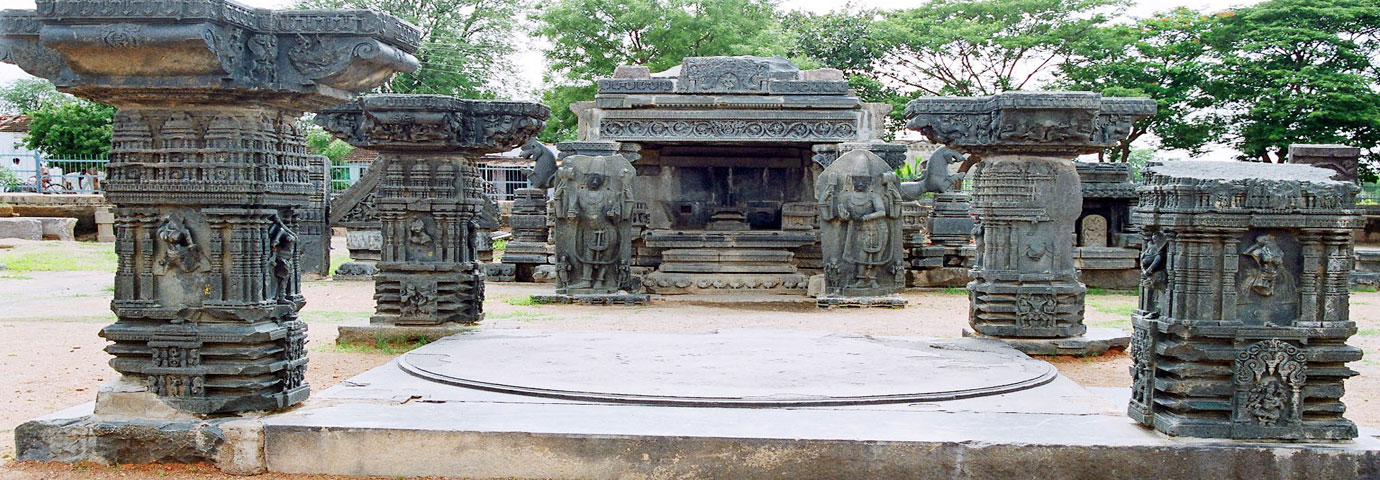Tourist Attractions in Warangal
The first sovereign ruler of the dynasty, King Rudradeva, built the exquisite Thousand-Pillar Temple at Hanamankonda in thanksgiving for victory in the battle with the Yadavas of Devagiri and dedicated the triple shrine or trikuta to Shiva, Vishnu, and Sun God. The imposing star-shaped temple complex within a walled enclosure has been constructed with finely carved black basalt, which was a great favorite with the Kakatiyas and their talented artisans.
King Ganapati Deva had once been taken captive in a battle. His brave and faithful commander-in-chief, Rudra, held temporary charge of the kingdom for his master. Later, as a reward for his loyalty and heroic struggle in freeing the king, he was bestowed with the fief of a large tract of land. At Palampet, 60 km north of Warangal, Rudra constructed a vast reservoir and a magnificent temple on its bank. The large lake met the needs for irrigation while the temple became the center for people from diverse walks of life to meet and exchange social as well as cultural ideas, apart from praying.
Guarded by exquisitely sculpted black basalt Nandi, the Ramappa Temple, dedicated to Lord Shiva, stands in solitude surrounded by a dilapidated stonewall shrouded by soothing greenery. Constructed in AD 1213, the red sandstone temple has several innovations of the Kakatiyas in traditional temple architecture.
An inscription engraved on the four sides of a stone pillar narrates the history of the temple as well as of the glorious achievements of General Rudra, the builder of the temple.
Five kilometers south of Warangal lay the historic fort of the Kakatiyas and the ruins of the citadel. King Rudradeva started construction of this impregnable Warangal Fort in the 12th century when the capital had to be shifted from Hanamankonda. It was further extended by his nephew and successor, Ganapati Deva and was finally completed by princess Rudramma -daughter of Ganapati Deva-who ruled for 30 years. Located near the Ekashila hill rock, the fort has an embattlement of a very deep and high mud wall fortified inside with massive blocks of stone joined together. Rudramma had further strengthened defence of the fort with a deep and wide moat surrounding the double wall. A great warrior herself, Rudramma died at the age of 80 while leading her troops into the battlefield.
Today, the widely scattered ruins of the once magnificent Warangal Fort is an open-air museum of Kakatiya art and architecture that reached its zenith during the reign of King Ganapati Deva. The main attractions within the fort are the fragments of the majestic Sahastralinga Temple strewn over a large area. Its four massive torans, however, still stand erect. Plundered and devastated by Ibrahim Qutab Shah, the remains of the imposing temple exhibit until this day the excellence of Kakatiya architectural art. Impeccable delicate sculptures in black basalt on ornamental doorways, perforated stone lattice screen with repetitions of decorative patterns and motifs depicting unusual animal forms, Yali, vibrant leonine figures and graceful swans with swirling tail feathers, the insignia of the dynasty, are all an amazing experience for the viewer. Centuries of fierce weathering could not fade their mirror-like gloss nor erode the relief and texture.





